https://en.wikipedia.org/wiki/Sandham_Memorial_Chapel
Sandham Memorial Chapel
British Masters - We Are Making a New World (Episode One)
https://www.youtube.com/watch?v=-jUsdN1HKLk&t=14s
47分-55分?
The Chapel is consecrated 'The Oratory of All souls' and only became officially recognised by its colloquial name Sandham Memorial Chapel following the National Trust's takeover of the property. Spencer would refer to it as his 'Holy-Box', whilst the architect and patrons would privately refer to it as Spencer's 'God-Box'. Meanwhile, John and Mary Behrend's children pejoratively called it the 'biscuit factory' in response to its municipal features.[4]
google translate
教堂被奉為“所有靈魂的演說家”,只有在國家信託接管財產之後才被其俗名的桑德姆紀念教堂正式承認。 斯賓塞會把它稱為他的“聖盒”,而建築師和讚助人會私密地把它稱為斯賓塞的“上帝盒”。 同時,約翰和瑪麗·貝德森的孩子們貶義地稱之為“餅乾工廠”,以響應其市政特色。[4]
HC修正:末句待查
教堂被奉為“萬靈聖堂”,只有在國家信託接管財產之後(1984)才正式承認,取其俗名的"桑德姆紀念教堂"。 斯賓塞會把它稱為他的“聖盒”,而該教堂的建築師和讚助人會私密地把它稱為斯賓塞的“上帝盒”。 同時,約翰和瑪麗·貝德森的孩子們貶義地稱之為“餅乾工廠”,以響應其市政特色。[4]
All Souls' Day :追思已亡日;亡人節;萬靈節(基):是隱修院院長聖奧迪洛( Odilo )於 998 年首先在其所屬隱修院提倡、後來推展成為普世教會的敬禮,於每年十 一月二日 舉行追思已亡日,特別為逝世(信徒)的靈魂祈禱,現已納入教會禮儀中。教宗本篤十五世特准神父當天可為亡者舉行三台(次)彌撒。中國除此日外,每年清明節教會也特別舉行追思祖先的儀式和祈禱(彌撒)。
oratory :聖堂;小教堂:拉丁文稱作 oratorium ,是經教會教長之准許,開放為敬禮天主的地方,以便利某一團體的信徒使用(法典 1223 );與公開之大教堂 church 相對照。參閱 church 。
Stanley Spencer 1891-1959
https://en.wikipedia.org/wiki/Stanley_Spencer
British Masters - In Search of England (Episode 2)
https://www.youtube.com/watch?v=_HLZ7IBRxdA
Stanley Spencer
(b Cookham, Berkshire, 30 June 1891; d Taplow, nr. Cookham, 14 Dec. 1959). English painter, one of the most original figures in 20th-century British art. He lived for most of his life in his native village of Cookham, which played a large part in the imagery of his paintings. His education was fairly elementary, but he grew up in a family in which literature, music, and religion were dominant concerns and his imaginative life was extremely rich.
Text Source: The Oxford Dictionary of Art and Artists (Oxford University Press)
Stanley Spencer - Wikipedia, the free encyclopedia
https://en.wikipedia.org/wiki/Stanley_Spencer
Sir Stanley Spencer KCB CBE RA (30 June 1891 – 14 December 1959) was an English painter. Shortly after leaving the Slade School of Art, Spencer became ...'Self-Portrait', Sir Stanley Spencer | Tate
www.tate.org.uk/art/artworks/spencer-self-portrait-t03335
This is Spencer's final self-portrait and one of his last paintings. In December 1958 he discovered that he was suffering from cancer and underwent an operation.'The Resurrection, Cookham', Sir Stanley Spencer | Tate
www.tate.org.uk/art/artworks/spencer-the-resurrection-cookham-n04239
Sir Stanley Spencer, The Resurrection, Cookham 1924–7. © Tate. © Tate ... Artwork details. Artist. Sir Stanley Spencer 1891–1959. Title. The Resurrection, Cookham ... Sir Stanley Spencer 'Self-Portrait', 1914 © Estate of Stanley Spencer.Stanley Spencer - WikiArt.org
www.wikiart.org/en/stanley-spencer
hc請教梁永安先生,獲得末句的解答,謝謝。
⋯⋯Stanley Spencer: Letters offer a portrait of the artist as a young man
- 1 October 2016
- Entertainment & Arts
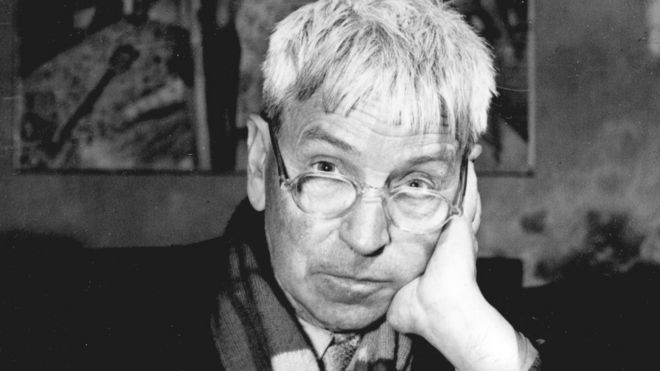 AP
AP
At 90, Shirin Spencer can still recall her father Stanley painting one of his masterpieces - the World War One murals at the chapel in Burghclere in Hampshire. Now she's looking forward to new light being shed on his war as the family publishes the correspondence of the artist as a young man.
It is 57 years since the painter Sir Stanley Spencer died. Interest in his work and his sometimes tangled private life has, if anything, grown since then.
When he died, his eldest daughter Shirin was already working with a view to publishing his correspondence.
But she did not have the heart to continue, and decades later her nephew John has taken up the job.
There are some five million words to work through. The first of three volumes, covering the early years and a war spent mainly in Macedonia, comes out this autumn.
Shirin says people often know two things about her father - that he grew up in Cookham in Berkshire and that he painted the murals at the Sandham Memorial Chapel.
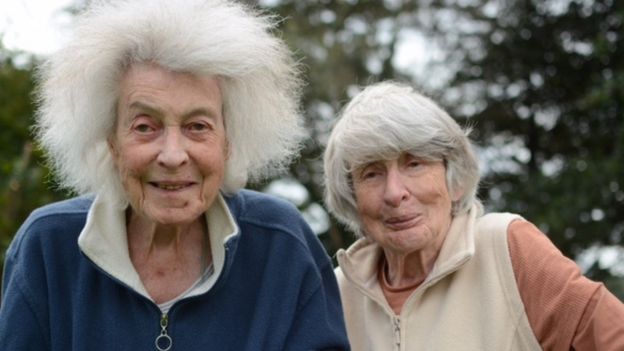 JOHN SPENCER
JOHN SPENCER
"My father loved Cookham deeply and people will see that again in the letters," she says.
"Probably he'd barely been further than Maidenhead until he went to the Slade School of Art in London when he was 17."
Towards the end of his life, the BBC filmed Sir Stanley walking around the village looking slightly eccentric with a pram. The image has defined what some people think of him.
Shirin is sitting next to her younger sister Unity. They now live close to one another in Wales, though in separate houses. They are good company but Unity does not hesitate to make clear how much she dislikes talk of their father as an eccentric.
"There were shots of Daddy taking the pram over Cookham Moor with an artist's easel in it, which probably did make him look odd," she says.
"But I don't think he was at all eccentric - he got up and shaved and had his breakfast and got on with his work. The eccentricity was something invented by people who didn't know him at all. In many ways he was a normal bloke."
Around the time of Shirin's birth, Sir Stanley began work on the interior of the new chapel in Hampshire - work which took five years.
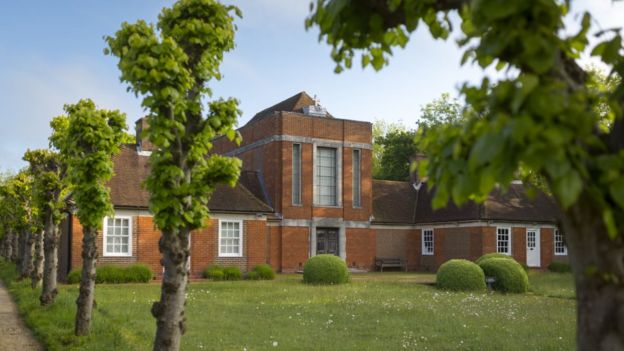 NATIONAL TRUST
NATIONAL TRUST
From the outside, the building is not especially attractive - some said it resembled municipal offices or a biscuit factory.
But Sir Stanley covered the interior with 19 colourful and extraordinary images, inspired both by the great masters of Renaissance painting and by his own war years.
He had spent most of the war in the Royal Army Medical Corps, at home and in the eastern Mediterranean.
The pictures range from the homely to the wildly dramatic.
The dominant central image, over the altar, is The Resurrection of the Soldiers. It shows fallen servicemen after the war, emerging from their graves in Macedonia and sending the white wooden crosses tumbling across the canvas.
In the middle of the picture, two mules lie on the ground. Almost insignificant in the middle distance, Christ looks on.
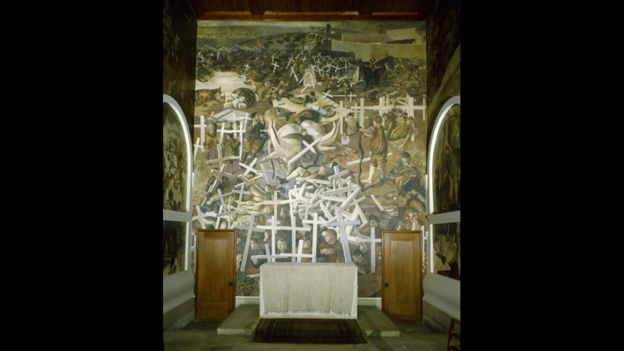 BRIDGEMAN IMAGES
BRIDGEMAN IMAGES
Shirin can remember being taken when small to see her father at work at Burghclere.
She was especially fond of the mules then, and today she thinks the Resurrection is the greatest and most inspiring of all her father's pictures.
"The major themes of his life were redemption and resurrection," she says. "So he had everything in his mind before he even started.
"People ask why Christ is such a small figure in The Resurrection of the Soldiers but if you see it in the context of the chapel it all works marvellously.
"Christ is welcoming the soldiers but I think he's doing it almost man to man - he's chatting with them. Our father was interested in ordinary things which to him were almost sacramental - they had a life of their own."
'Happy memories'
Unity says her father thought a lot about religious belief but never had a standard view of Christianity.
"But in the picture there's a lovely line of trees stretching up the hill and an amazing sense of eternity. Daddy thought Jesus was an interesting and a good man - but I don't think he quite knew what he thought about God."
Sir Stanley brought his children to live in Cookham in 1932, but five years after that his marriage to their mother Hilda ended in divorce.
The family broke up and he quickly married Patricia Preece. It was a relationship, apparently unconsummated, which has baffled biographers.
A major film company has approached the family about turning the tale into a biopic.
John Spencer is still studying some of the letters from and to his grandfather in the years when the marriage was under pressure.
They will appear in the second volume he's currently editing, and John says the anger is striking.
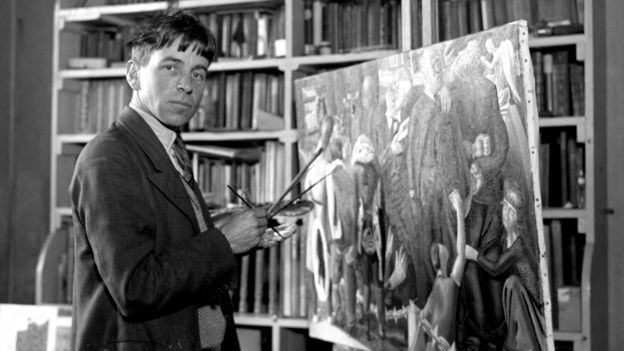 PA
PA
Shirin saw little of her father between the ages of six and 13.
"I wish I had seen more of him but there were happy memories too. I can remember going with him to Odney Common and playing ducks and drakes - skimming stones over the surface of the water.
"And I remember him getting me a scented rush to smell. There were times when he was an ordinary father and a good father."
Unity recalls being upset when she first went to the chapel at Burghclere when she was aged 10 or 11.
"It simply had never occurred to me that he was famous," she says. "But when I saw the chapel I realised he was a public figure and I came away with my head low - I felt I had lost my Daddy."
The three new volumes of correspondence will contain a few images of paintings, but there are previously unseen little sketches which Sir Stanley sometimes drew on his letters.
Shirin says she hopes the books will give people a more accurate picture of her father.
"He had a real interest in people and he was a very kind man. There was a time when Unity and I didn't see him but he was kind. And I hope that people will know that because it's very important."
Stanley Spencer - Looking to Heaven is published in November by the Unicorn Press.
Witness: Stanley Spencer is available on the BBC World Service website.

沒有留言:
張貼留言